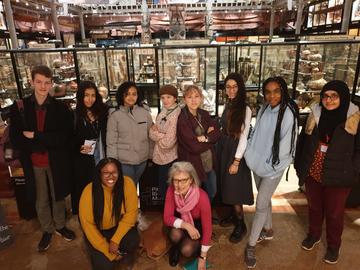Labelling Matters Project
Let’s begin with a mistake…

The museum is crowded, OSA students Teoni and Abigail are stood in front of a Gabonese wooden door carved with a figure holding a machete-like tool and displaying signs of scarification. As they lean into the microphone, they begin to describe the door and immediately refer to the carved figure as ‘he’. Their male characterisation is incorrect, the internal database revealing that the figure is female. Their error is understandable, the figure is androgynous and we have been conditioned to associate ‘weaponry’ with masculinity, and the label simply reads ‘figure’. Their error remains a part of the podcasts, a remainder of the purpose of the project to question how we talk, interpret and view objects.
I first met the eight Year 12 students at Oxford Spires Academy in November. I felt that it was important to meet them for the first time in their comfort zone, knowing we would probably delve into some uncomfortable subjects. I introduced them to the Pitt Rivers and the Labelling Matters project and over the next hour tried to complex topics such as collections and colonialism, curatorial voice and decoloniality. Although initially slow going, they were all soon questioning the idea of expertise, and why some knowledge was deemed more important than others (specifically they questioned why their voices as youth were seen as less important or not expert).
Over the next five workshops, I was always constantly surprised by the directions of our conversations and the choices of objects chosen by the students. However, their podcasts illustrate that our many and often tangential discussions resonated deeply with each student as they were teasing out the bigger issues of representation, cultural appropriation, colonialism and language within their snippets of audio.
Amber connected with her New Zealand ancestry and confronted the complex stories of cultural appropriation of Maori symbolism and contemporary New Zealander identity, all triggered by coming face to face with an object that she had previously considered a household trinket. Her re-examination of the hei tiki, illustrates the power that museums lend to objects (whether for better or worse), and proves that these spaces matter and that ways we interpret these objects has a lasting impact.
Linnet’s journey drove home one of the key issues I believe a lot of museums face…an absence of people. The Pitt Rivers Museum uses the tagline ‘a democracy of things’ to promote our typological display. However, as Linnet stated in her post ‘they are not objects, but people’s stories’, which suggests that we need to focus on ‘a democracy of people’ within the museum rather than things. It is not surprising that some scholars have taken to using the term ‘possessions’ instead of objects; that simple word change puts people back at the centre of museum practice and opens up the interpretive potential.
Amaani’s poem is a great example of how museums can inspire. It also shows how we need to be more inclusive about who can speak for these objects. Amaani, as British Asian teenager was able to connect and write about Indian iron anklets, because of stories told by her mother about nazar or the evil eye. Her poem thus comes from a place that is multi-generational, imbued with the voices of many women that came before her. Amaani’s use of poetry to explore her object reminded me of the Museum of Colour-People of Letters event that the Pitt Rivers collaborated with and hosted last September, in which a number of writers and a musician developed a piece of work around an object of their choice. The result was illuminating, in their work and through their experience and heritage as these objects were provided with a much more expansive form of labelling, which sparks a discussion on what is a label? (see below for a link to the People of Letters project)
Pamela ran head first into the issue of repatriation while researching the ‘aumakua hulu manu or Hawaiian feathered god head. As an artist she was drawn to the strong visual nature of the piece, but also realised that its story is still ongoing and its power is still very much real to the Hawaiian community whom is requesting the repatriation of this culturally significant object. None of this being conveyed in the display or label around the ‘aumakua hulu manu, Pamela decided to paint a label for the object. Her painting captured the powerful essence she felt from the feathered god head and re-imagining it with its original vibrant red feathers and depicted the hair as lively tendrils.
Celeste questioned the notion of mental illness in other cultures and how it was perceived. Max, a frequent visitor to the Pitt Rivers from a young age, finally began to question the lives of these objects prior to their display at the PRM and how colonialism played a part in the movement of objects especially a Myanmar sword with a beautifully carved ivory handle. Finally, back to Teoni and Abigail, who discussed the body modification of scarification and looked at negative connotations that were used to describe the modification within the museum. The language created a linguistic hierarchy to support Eurocentric beauty ideals.
The podcasts are all works in progress, some taking the personal route, deep historical dives, and others the beginning of a question. No matter the finished product, these students have all proven that they have things to say and that they can be impactful.
Museum of Colour, People of Letters Response Gallery: https://museumofcolour.org.uk/people-of-letters-response-gallery/the-tiger-baby-that-never-was?piece=41



